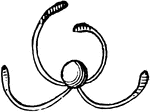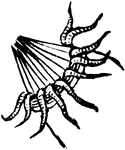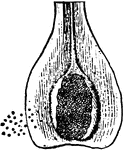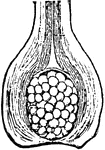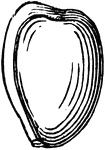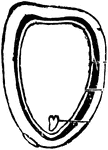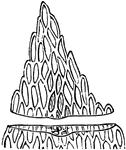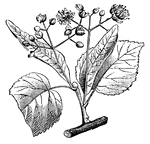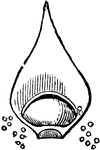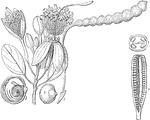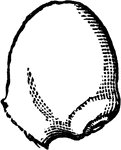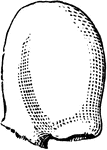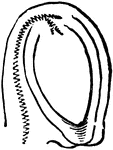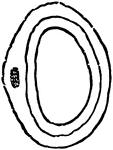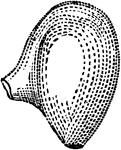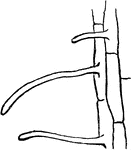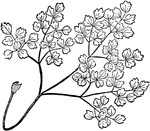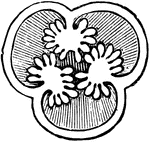
Hypericum graveolens
Cross section of an ovary of Hypericum graveolens with the placentae now separate and rounded.
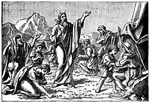
The Israelites Gather Manna Sent by God
"And when the dew that lay was gone up, behold, upon the face of the wilderness a small round thing,…
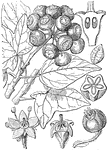
Ivy
"1. Hedera Helix; 2. a flower of Dimorphanthus edulis; 3. perpendicular section of the ovary; 4. undivided…

Jersey Pine Needles
This shows the cluster of two leaves, bright green, of the Jersey Pine, Pinus virginiana, (Keeler, 1915).
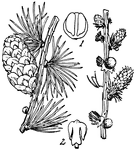
Larch, Cone and Flowers (male and female)
Larch, or Larix, is a genus of hardy, deciduous, coniferous trees of very graceful habit. They bear…
Large-Toothed Aspen Flowers
This shows the fruiting ament of Large-toothed Aspen, Populus grandidentata, (Keeler, 1915).
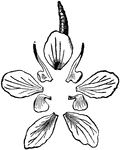
Larkspur
Its calyx and corolla displayed; the five large parts are the sepals; the four smaller, of two shapes,…

Laurel Dodder
"Cassytha filiformis. 1. a flower; 2. a fruit; 3. a section of it transversely." -Lindley, 1853

The Lentil Plant
This illustration shows a lentil plant. Lentils are the round, flat seeds of a small leguminous plant…

Lichens
A stone on which various Lichens are growing, such as (passing from left to right) a Parmelia, a Sticta,…

Egyptian Blue Lily
"Nymphaea coerulea. 1. a perpendicular section of a seed of N. alba; 2. half an embryo, showing the…
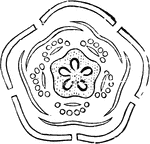
Linden
Diagram of a flower of Linden, showing the calyx valvate and corolla imbricate in the bud, etc.
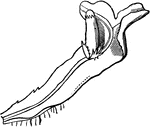
Liverworts
One of the frondose Liverworts, Steetzia, otherwise like a Jungermannia; the spore-case not yet protruded…

Loblolly Pine Needles
This shows the cluster of three, slightly twisted leaves of the Loblolly Pine, Pinus taeda, (Keeler,…

Locust Blossom Seeds
These are the seeds or racemes of the Locust blossoms, Robinia pseudoacacia,(Keeler, 1915).

Ekebergia
Of the Mahogany family, "Ekebergia Senegalensis. 1. a flower; 2. the calyx and staminal tube; 3. a transverse…

Maiden-hair
A young prothallus of a Maiden-hair and an older one with the first fern-leaf developed from near the…

Maiden-hair
A young prothallus of a Maiden-hair, middle portion of the younger one, partly among the rootlets, the…
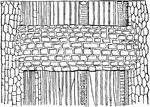
Maple
Surface of a young Maple wood from which the bark has been torn away, showing the bark (on the left)…
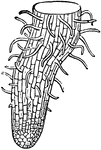
End of Maple Root
Lower end of Maple root magnified, the root seen just as root-hairs are beginning to for a little behind…

Maple Seedling
Seedling Maple, of the natural size; the root well supplied with root hairs, here large enough to be…
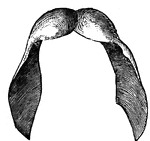
Maple Seeds
Here is a representation of two seeds of the maple, with their wings. They always grow in this way,…

Marignia
"Marignia obtusifolia. 1. a flower; 2. the same divided vertically; 3. a fruit; 4. a section of the…
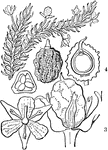
Mayaca
"Mayaca vandellii; 1. a flower; 2. a cross section of its ovary; 3. a seed vessel; 4. two seeds, one…


